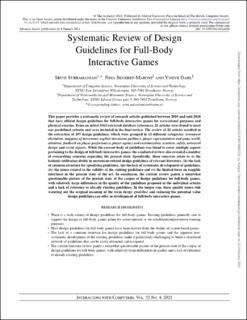| dc.description.abstract | This paper provides a systematic review of research articles published between 2010 and mid-2018 that have offered design guidelines for full-body interactive games for recreational purposes and physical exercise. From an initial 3562 retrieved database references, 22 articles were found to meet our predefined criteria and were included in the final review. The review of 22 articles resulted in the extraction of 107 design guidelines, which were grouped in 12 different categories: movement elicitation, mapping of movement, explicit movement guidance, player representation and game world, attention, feedback on player performance, player agency and customization, exertion, safety, universal design and social aspects. While the current body of guidelines was found to cover multiple aspects pertaining to the design of full-body interactive games, the conducted review also revealed a number of overarching concerns regarding the present state. Specifically, these concerns relate to (i) the hedonic–utilitarian divide in movement-related design guidelines of relevant literature, (ii) the lack of common structure for specifying guidelines, (iii) the lack of systematic development of guidelines, (iv) the issues related to the validity of the existing guidelines and (v) the limited focus on tangible interfaces in the present state of the art. In conclusion, the current review paints a somewhat questionable picture of the present state of the corpus of design guidelines for full-body games, with relatively large differences in the quality of the guidelines proposed in the individual articles and a lack of reference to already existing guidelines. In the longer run, these quality issues risk watering out the original meaning of the term design guideline and reducing the potential value design guidelines can offer in development of full-body interactive games. | en_US |

